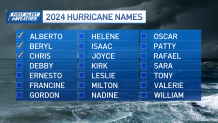
Since Hurricane Beryl and short-lived Tropical Storm Chris in early July, the tropics have been quiet due to the Saharan Air Layer. However, activity may pick up as we head into August.
The Saharan Air Layer (SAL) is a plume of dry, dusty air that forms over the Sahara Desert during the late spring, summer, and early fall.
WATCH ANYTIME FOR FREE
>Stream NBC10 Boston news for free, 24/7, wherever you are. |
According to the National Oceanic and Atmospheric Administration (NOAA), the layer can extend from 5,000 to 20,000 feet into the atmosphere.
Trade winds carry the dust thousands of miles west from Africa across the Atlantic Ocean, as far west as Florida, Texas and Central America. Satellites and forecast models allow even our NBC10 Boston First Alert Weather Team to track the dust as it makes its trek across the Atlantic.
Get updates on what's happening in Boston to your inbox. Sign up for our >News Headlines newsletter.
During the peak of the SAL, which is typically from late June to mid-August, hurricane activity is much lower due to the layer’s dense, dry air and increased wind shear. Vertical wind shear can rip a storm apart as it tries to develop. With an ample amount of dry air in the atmosphere, tropical storms and hurricanes have a hard time developing and/or getting stronger.
While the SAL is still occurring at moderate levels, especially near the coast of Africa, there are favorable conditions in the Caribbean for a slow formation of the next named storm. The combination of a disturbance in the Central Atlantic and a tropical wave coming together in the next two days creates a 50% chance of development.

The National Hurricane Center has highlighted the Greater Antilles, Bahamas, and Florida in the potential development zone by the end of the week. The greater Antilles or Bahamas would likely see impacts first before Florida. Residents in these areas should closely monitor this potential storm as it evolves. The next name on the 2024 name list is Debby.
Remember, NOAA is predicting an above-normal hurricane season this year, and along those same lines, Colorado State University is forecasting an “extremely active 2024 season.”


